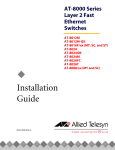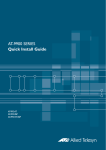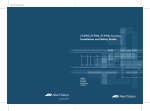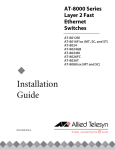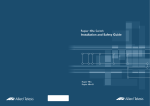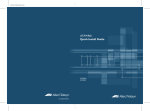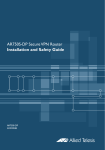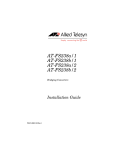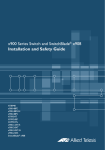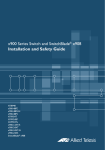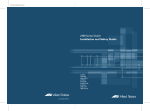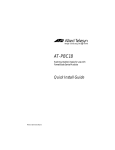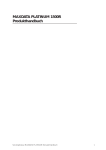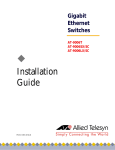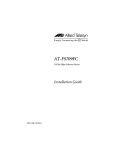Download Allied Telesis AT-8400 Series Installation guide
Transcript
AT-8400 Chassis AT-8400 ◆ Installation Guide PN 613-50395-00 Rev B ® Copyright 2003 Allied Telesyn, Inc. 960 Stewart Drive Suite B, Sunnyvale, CA 94085 USA All rights reserved. No part of this publication may be reproduced without prior written permission from Allied Telesyn, Inc. All product names, company names, logos or other designations mentioned herein are trademarks or registered trademarks of their respective owners. Allied Telesyn, Inc. reserves the right to make changes in specifications and other information contained in this document without prior written notice. The information provided herein is subject to change without notice. In no event shall Allied Telesyn, Inc. be liable for any incidental, special, indirect, or consequential damages whatsoever, including but not limited to lost profits, arising out of or related to this manual or the information contained herein, even if Allied Telesyn, Inc. has been advised of, known, or should have known, the possibility of such damages. Electrical Safety and Emission Compliance Statement Standards: This product meets the following standards: U.S. Federal Communications Commission Radiated Energy Note: This equipment has been tested and found to comply with the limits for a Class A digital device pursuant to Part 15 of the FCC Rules. These limits are designed to provide reasonable protection against harmful interference when the equipment is operated in a commercial environment. This equipment generates, uses, and can radiate radio frequency energy and, if not installed and used in accordance with this instruction manual, may cause harmful interference to radio communications. Operation of this equipment in a residential area is likely to cause harmful interference in which case the user will be required to correct the interference at his own expense. Note: Modifications or changes not expressly approved by the manufacturer or the FCC can void your right to operate this equipment. Industry Canada This Class A digital apparatus meets all requirements of the Canadian Interference-Causing Equipment Regulations. Cet appareil numérique de la classe A respecte toutes les exigences du Règlement sur le matériel brouilleur du Canada. RFI Emission FCC Class A, EN55022 Class A, EN61000-3-2, EN61000-3-3, VCCI Class A, C-TICK 1 Warning: In a domestic environment this product may cause radio interference in which case the user may be required to take adequate measures. 2 Immunity EN55024 3 Electrical Safety EN60950 (TUV), UL60950 (UL/cUL) 4 Laser EN60825 5 Important: Appendix A contains translated safety statements for installing this equipment. When you see the , go to Appendix A for the translated safety statement in your language. Wichtig: Anhang A enthält übersetzte Sicherheitshinweise für die Installation dieses Geräts. Wenn Sie sehen, schlagen Sie in Anhang A den übersetzten Sicherheitshinweis in Ihrer Sprache nach. Vigtigt: Tillæg A indeholder oversatte sikkerhedsadvarsler, der vedrører installation af dette udstyr. Når De ser symbolet , skal De slå op i tillæg A og finde de oversatte sikkerhedsadvarsler i Deres eget sprog. Belangrijk: Appendix A bevat vertaalde veiligheidsopmerkingen voor het installeren van deze apparatuur. Wanneer u de ziet, raadpleeg Appendix A voor vertaalde veiligheidsinstructies in uw taal. Important: L'annexe A contient les instructions de sécurité relatives à l'installation de cet équipement. Lorsque vous voyez le symbole , reportez-vous à l'annexe A pour consulter la traduction de ces instructions dans votre langue. Tärkeää: Liite A sisältää tämän laitteen asentamiseen liittyvät käännetyt turvaohjeet. Kun näet -symbolin, katso käännettyä turvaohjetta liitteestä A. Importante: l’Appendice A contiene avvisi di sicurezza tradotti per l’installazione di questa apparecchiatura. Il simbolo , indica di consultare l’Appendice A per l’avviso di sicurezza nella propria lingua. Viktig: Tillegg A inneholder oversatt sikkerhetsinformasjon for installering av dette utstyret. Når du ser , åpner du til Tillegg A for å finne den oversatte sikkerhetsinformasjonen på ønsket språk. Importante: O Anexo A contém advertências de segurança traduzidas para instalar este equipamento. Quando vir o símbolo , leia a advertência de segurança traduzida no seu idioma no Anexo A. Importante: El Apéndice A contiene mensajes de seguridad traducidos para la instalación de este equipo. Cuando vea el símbolo , vaya al Apéndice A para ver el mensaje de seguridad traducido a su idioma. Obs! Bilaga A innehåller översatta säkerhetsmeddelanden avseende installationen av denna utrustning. När du ser , skall du gå till Bilaga A för att läsa det översatta säkerhetsmeddelandet på ditt språk. iii iv Table of Contents Preface ....................................................................................................................................................................................................................vii How This Guide is Organized ...........................................................................................................................................................................vii Where to Find Related Guides ........................................................................................................................................................................viii Document Conventions ..................................................................................................................................................................................... ix Contacting Allied Telesyn ................................................................................................................................................................................... x Online Support............................................................................................................................................................................................... x Email and Telephone Support .................................................................................................................................................................. x Returning Products....................................................................................................................................................................................... x For Sales or Corporate Information ........................................................................................................................................................ x Management Software Updates.............................................................................................................................................................. x Chapter 1 AT-8400 Series Switch Overview .................................................................................................................................................................. 1 Overview ................................................................................................................................................................................................................... 2 Hardware Features ................................................................................................................................................................................................ 3 Software Features .................................................................................................................................................................................................. 3 Front and Back Panel Components ................................................................................................................................................................. 5 Chapter 2 Installing the AT-8400 Chassis ...................................................................................................................................................................... 7 Overview ................................................................................................................................................................................................................... 8 Verifying Package Contents....................................................................................................................................................................... 9 Preparing the Site........................................................................................................................................................................................ 10 Reviewing Safety Precautions................................................................................................................................................................. 10 Installing the Chassis on a Desktop ...............................................................................................................................................................12 Installing the Chassis in a Rack ........................................................................................................................................................................13 Cabling and Powering on the Chassis ..........................................................................................................................................................16 Connecting the Frame Ground .......................................................................................................................................................................17 Powering on an AC Chassis ..............................................................................................................................................................................19 Powering on a DC Chassis .................................................................................................................................................................................20 Warranty Registration .........................................................................................................................................................................................22 Chapter 3 Installing and Removing Line Cards .........................................................................................................................................................23 Overview .................................................................................................................................................................................................................24 Verifying Package Contents..................................................................................................................................................................... 24 Installing a Line Card ...........................................................................................................................................................................................25 Removing a Line Card ........................................................................................................................................................................................30 v Table of Contents Software Implications of Replacing Line Cards ........................................................................................................................................ 33 Hotswapping and Port Trunking........................................................................................................................................................... 34 Hotswapping and VLANs ......................................................................................................................................................................... 35 Hotswapping with STP and RSTP.......................................................................................................................................................... 35 Appendix A Technical Specifications ................................................................................................................................................................................ 37 Overview ................................................................................................................................................................................................................. 37 Physical Characteristics ..................................................................................................................................................................................... 37 Power Requirements .......................................................................................................................................................................................... 38 Agency Certifications ......................................................................................................................................................................................... 38 Appendix B Translated Safety Information ................................................................................................................................................................... 39 vi Preface This installation guide contains a description of the AT-8400 Series switch as well as instructions on how to install an AT-8400 chassis and the AT-8400 line cards. How This Guide is Organized This guide contains the following chapters and appendices: Chapter 1, AT-8400 Series Switch Overview, describes the features and functions of the AT-8400 Series switch. Chapter 2, Installing the AT-8400 Chassis, explains how to install the chassis on a desktop or in a 19-inch rack as well as how to connect the frame ground and power on a chassis with AC or DC connections. Chapter 3, Installing and Removing Line Cards, provides a generic procedure for installing and removing AT-8400 line cards. Appendix A, Technical Specifications, provides technical specifications for the chassis. Appendix B, Translated Safety Information, contains multi-language translations of the safety and emission statements in this guide. vii Preface Where to Find Related Guides The Allied Telesyn web site at www.alliedtelesyn.com offers you an easy way to access the most recent documentation, software, and technical information for all of our products. For complete information on the AT-8400 chassis and the various line cards, refer to the following manual on the Allied Telesyn web site: ❑ AT-8400 Series Switch Reference Guide PN 613-50399-00 For instructions on how to manage the chassis and line cards, refer to the following software guides, which are also available on our web site: ❑ AT-S60 Management Software User’s Guide PN 613-50400-00 ❑ AT-S60 Management Software Command Line User’s Guide PN 613-50401-00 viii AT-8400 Chassis Installation Guide Document Conventions This guide uses the following conventions: Note Notes provide additional information. Warning Warnings inform that performing or omitting a specific action may result in bodily injury. Caution Cautions inform you that performing or omitting a specific action may result in equipment damage or loss of data. ix Preface Contacting Allied Telesyn This section provides Allied Telesyn contact information for technical support as well as sales or corporate information. Online Support Email and Telephone Support Returning Products You can request technical support online by accessing the Allied Telesyn Knowledge Base from the following web site: http://kb.alliedtelesyn.com. You can use the Knowledge Base to submit questions to our technical support staff and review answers to previously asked questions. For Technical Support via email or telephone, refer to the Support & Services section of the Allied Telesyn web site: http://www.alliedtelesyn.com. Products for return or repair must first be assigned a Return Materials Authorization (RMA) number. A product sent to Allied Telesyn without a RMA number will be returned to the sender at the sender’s expense. To obtain a RMA number, contact Allied Telesyn’s Technical Support at our web site: http://www.alliedtelesyn.com For Sales or Corporate Information x You can contact Allied Telesyn for sales or corporate information at our web site: http://www.alliedtelesyn.com. To find the contact information for your country, select Contact Us then Worldwide Contacts. AT-8400 Chassis Installation Guide Obtaining Management Software Updates New releases of management software for our managed products can be downloaded from either of the following Internet sites: • • the Allied Telesyn web site: http://www.alliedtelesyn.com the Allied Telesyn FTP server: ftp://ftp.alliedtelesyn.com If you would prefer to download new software from the Allied Telesyn FTP server from your workstation’s command prompt, you will need FTP client software and you will be asked to log in to the server. Enter ‘anonymous’ as the user name and your email address for the password. xi Preface xii Chapter 1 AT-8400 Series Switch Overview This chapter contains the following sections: Overview on page 2 Hardware Features on page 3 Software Features on page 3 Front and Back Panel Components on page 5 1 AT-8400 Series Switch Overview Overview The AT-8400 Series switch is a modular unit that simplifies the task of building and maintaining a Fast Ethernet or Gigabit Ethernet network. See Figure 1. With the AT-8400 Series switch, you can build an Ethernet network customized to the unique needs of your network environment. 1 2 3 4 5 6 M 7 8 9 10 11 12 Figure 1 AT-8400 Series Switch You can connect your workgroup hubs and other switches to the chassis so that the AT-8400 Series switch functions as the focal point of your network. Or you can connect workstations, servers, printers, and routers directly to the chassis so that each device has sole use of a dedicated link to the network. Below are the cards that are available for the AT-8400 Series switch. AT-8411 TX line card — Fast Ethernet with eight 10/100Base-TX twisted pair ports AT-8412/SC FX line card — Fast Ethernet with four fiber optic ports AT-8412/MT FX line card — Fast Ethernet with four fiber optic ports AT-8413 GB/T line card — Gigabit Ethernet with one twisted pair port and a slot for a GBIC module Note For a current list of line cards for the AT-8400 Series switch, refer to the Allied Telesyn web site or ask your authorized sales representative. The chassis can contain any combination of line cards, and in any order. 2 AT-8400 Chassis Installation Guide Hardware Features Hardware features of the AT-8400 Series switch include: 13 slots — 12 slots for line cards, such as Fast Ethernet and Gigabit Ethernet cards, and one slot for the AT-8401 management card One pre-installed AC or DC power supply (depending on the chassis model) One expansion slot for a redundant power supply One AT-8401 management card that supports the following management access methods: — Local (out-of-band) management using the RS-232 port on the card — Remote (in-band) management using Telnet, a web browser, or an SNMP application program Software Features Some of the software features of the AT-8400 Series switch and line cards include: AT-S60 management software — features menu, web browser, and command line interfaces Enhanced stacking — simplifies network management by allowing you to manage multiple AT-8400 and AT-8000 Series switches from one management session BOOTP and Dynamic Host Configuration Protocol (DHCP) — automatically loads internet protocol (IP) configuration information onto the AT-8400 Series switch Port-based and tagged VLANs (IEEE 802.1Q) — creates independent traffic domains Basic VLAN mode — forwards packets by MAC addresses only Auto-Negotiation (IEEE 803.3u compliant) — automatically sets port speed and duplex mode Spanning tree protocol (IEEE Std 802.1D), rapid spanning tree protocol (IEEE Std 802.1w), and multiple spanning tree protocol (IEEE Std 802.1s)— detect physical data loops in a network topology and blocks ports of redundant paths 3 AT-8400 Series Switch Overview Internet Group Management Protocol (IGMP) snooping (RFC 2236) — controls the flow of multicast packets for improved network performance Quality of Service (IEEE 802.1p-compliant) — features high and low priority queues for tagged frames Port trunking (IEEE 802.3ad) (static link aggregation, non LACP)— increases bandwidth between devices through load balancing across multiple data links Port mirroring — copies network traffic onto a switch port for network troubleshooting Port security — offers four levels of access security MAC address table — stores up to 8,000 addresses Backpressure and flow control (IEEE 802.3x and IEEE 802.3zcompliant) Stores and forwards packet handling Note For descriptions of the software features, refer to the AT-S60 Management Software User’s Guide and the AT-S60 Command Line User’s Guide. 4 AT-8400 Chassis Installation Guide Front and Back Panel Components Figure 2 illustrates the front panel of the chassis. 1 2 Power Supply Slots 3 4 Ethernet Card Slots 5 6 M 7 8 AT-8401 Management Card Slot 9 10 11 12 Ethernet Card Slots Figure 2 Front Panel of the AT-8400 Series Switch Figure 3 illustrates the rear panel of the AC model of the AT-8400 Series switch. ! FAN B AT-8403 WARNING This unit might have more than one power cord. To reduce the risk of electric shock, disconnect all power cords before servicing unit. PWR B PWR A FAN A AT-8403 Figure 3 Rear Panel of the AT-8400 Series Switch (AC Model) 5 AT-8400 Series Switch Overview Figure 4 illustrates the back panel of the DC model of the AT-8400 Series switch. ! FOR CENTRALIZED DC POWER CONNECTION, INSTALL ONLY IN A RESTRICTED AREA. FAN B AT-8403 B WARNING A This unit might have more than one power input. To reduce the risk of electric shock, disconnect all power inputs before servicing unit. 40-60VDC INPUT 40-60VDC INPUT FAN A AT-8403 Figure 4 Rear Panel of the AT-8400 Series Switch (DC Model) 6 Chapter 2 Installing the AT-8400 Chassis This chapter contains the following sections: ❑ Overview on page 8 ❑ Installing the Chassis on a Desktop on page 12 ❑ Installing the Chassis in a Rack on page 13 ❑ Cabling and Powering on the Chassis on page 16 ❑ Warranty Registration on page 22 7 Installing the AT-8400 Chassis Overview This chapter discusses how to install the AT-8400 chassis on a desktop or in a rack and the necessary preparations you need to make before installing the chassis. A rackmounting kit, that includes the brackets that are needed to mount the chassis in a 19-inch rack, is shipped with the chassis. Before you install the chassis, you need to make the following preparations: ❑ Verifying Package Contents on page 9 ❑ Preparing the Site on page 10 ❑ Reviewing Safety Precautions on page 10 8 AT-8400 Chassis Installation Guide Verifying Package Contents Make sure the following items are included in your package. If items are missing or damaged, contact your Allied Telesyn sales representative for assistance. ❑ One AT-8400 chassis ❑ One rackmounting kit ❑ AT-8400 Chassis Installation Guide ❑ Warranty card 9 Installing the AT-8400 Chassis Preparing the Site Be sure to observe the following guidelines when planning the installation of your chassis. ❑ Make sure power for the chassis is accessible and cables can be easily connected. ❑ Cables must be away from sources of electrical noise such as radios, transmitters, broadband amplifiers, power lines, fluorescent or halogen light fixtures. ❑ Air flow around the chassis and through its vents on the rear panel should not be restricted. ❑ If you are using the chassis on a desktop, make sure it is placed on a level, secure surface. ❑ Do not place objects on top of the chassis. ❑ Do not expose the chassis to moisture or water. ❑ Make sure the chassis is in a dust-free environment. ❑ Use dedicated power circuits or power conditioners to supply reliable electrical power to the network devices. Reviewing Safety Precautions Please review the following safety precautions before you install the AT-8400 chassis, the AT-8401management card, and AT-8400 line cards. (The first two warnings apply only if you purchased a line card with a fiber optic port.) Warning Class 1 Laser product. 6 Warning Do not stare into the laser beam. 7 Warning Electric Shock Hazard: To prevent electric shock, do not remove the cover. There are no user-serviceable parts inside. The unit contains hazardous voltages and should only be opened by a trained and qualified technician. 8 Warning Lightning Danger: Do not work on this equipment or cables during periods of lightning activity. 9 10 AT-8400 Chassis Installation Guide Caution Power cord is used as a disconnection device: To de-energize equipment, disconnect the power cord. 10 Warning Electrical-Type Class 1 Equipment: This equipment must be earthed. The power plug must be connected to a properly wired earth ground socket outlet. An improperly wired socket outlet could place hazardous voltages on accessible metal parts. 11 Caution Pluggable Equipment: The socket outlet should be installed near the equipment and should be easily accessible. 12 Caution Air vents: The air vents must not be blocked on the unit and must have free access to the room ambient air for cooling. 13 Caution Operating Temperature: This product is designed for a maximum ambient temperature of 40°C. 14 Caution All Countries: Install this product in accordance with local and National Electric Codes. 15 Warning Remove all metal jewelry, such as rings and watches, before installing or removing a line card from a powered on chassis. 11 Installing the AT-8400 Chassis Installing the Chassis on a Desktop This section explains how to install the chassis on a desktop. To install the chassis in a rack, see Installing the Chassis in a Rack on page 13. For desktop installation, perform the following procedure: 1. Unpack all the items from the shipping container and store the packaging material in a safe location. Note Keep the shipping material. You must use the original shipping material if you need to return the chassis to Allied Telesyn. 2. Place the chassis down on a level, secure surface. See Figure 5. The chassis is equipped with four protective rubber feet. This allows the chassis to be placed on many types of surfaces. 1 PWR AT-84 11 2 PWR AT-84 11 3 AT-84 11 4 AT-84 11 RDY 5 AT-84 11 RDY RDY 6 M AT-84 01 7 RS-2 TERM 32 INAL POR T 8 9 10 11 12 PWR MGMT FAN FLT MSTR A WAIT/ REMO VE RESE FAN B T LNK 10 EJEC T ACT 100 LNK EJEC 10 T ACT 100 LNK EJEC 10 T ACT 100 LNK EJEC 10 T ACT 100 LNK 10 EJEC T ACT 100 Figure 5 Desktop Installation 3. Do not apply power at this time. Go to Connecting the Frame Ground on page 17. 12 AT-8400 Chassis Installation Guide Installing the Chassis in a Rack The chassis can be installed in a 19-inch rack. Allied Telesyn recommends that you install the chassis in the rack after installing the following into the chassis: ❑ AT-8401 management card ❑ AT-8400 line cards ❑ Power supply Since a fully assembled chassis is heavy, Allied Telesyn recommends two people lift it into a rack. See the Warning below. Warning Safety Hazard- A chassis with one AT-8401management card, five AT-8411 line cards, and one power supply weighs 12.98 kg (28.85 lbs). Be sure to take the weight into consideration when selecting a shelf on a rack and lifting the chassis. For rackmount installation, perform the following procedure: 1. If desired, remove the protective rubber feet from the bottom of the chassis, if attached, as shown in Figure 6. This is an optional step. Before removing the feet, carefully place the chassis upside down. Removing the feet allows you to have more space to install the Chassis into the rack. Figure 6 Removing the Protective Rubber Feet 13 Installing the AT-8400 Chassis 2. Attach the brackets to the sides of the chassis with four screws (not provided) on each side. There are two ways to attach the brackets. You can flip the ears of the brackets to the front, as shown in Figure 7. Or, you can flip the ears of the brackets to the rear, as shown in Figure 8. When the ears of the brackets are flipped to the rear, the chassis sticks out from the rack 4.31 inches (10.95 cm). 1 AT-841 1 2 AT-841 1 RDY 3 AT-841 1 RDY 4 AT-841 1 RDY 5 AT-841 1 RDY 6 RDY M AT-840 1 7 RS-23 TERM 2 INAL PORT 8 9 10 11 12 PWR FLT MGMT MSTR FAN A FAN WAIT/ REMOV B E RESET LNK 10 EJECT ACT 100 LNK 10 EJECT ACT 100 LNK 10 EJECT ACT 100 LNK 10 EJECT ACT 100 LNK 10 EJECT ACT 100 Figure 7 Attaching the brackets, with the ears flipped to the front 1 AT-841 1 2 AT-841 1 RDY 3 AT-841 1 RDY 4 AT-841 1 RDY 5 RDY PWR AT-841 1 6 M AT-840 1 7 RS-23 TERM 2 INAL PORT 8 9 10 11 12 PWR MGMT FLT MSTR FAN A WAIT/ REMOV E FAN B RESET LNK 10 EJECT ACT 100 LNK 10 EJECT ACT 100 LNK 10 EJECT ACT 100 LNK 10 EJECT ACT 100 LNK 10 EJECT ACT 100 Figure 8 Attaching the brackets, with the ears flipped to the rear Note The chassis may be heavy and awkward to lift. It is recommended that you get assistance with the next step. 14 AT-8400 Chassis Installation Guide 3. Attach the chassis to the rack with two screws (not provided) on each side. Refer to Figure 9 on page 15. Note The brackets are designed to be installed in a 3.5RU opening on a standard rack. 7 8 9 10 11 12 Figure 9 Installing the Chassis in a Rack 4. Go to the next section for procedures on how to attach the frame ground and how to apply power. 15 Installing the AT-8400 Chassis Cabling and Powering on the Chassis The following subsections describe how to cable and power on the AT-8400 chassis. First, you need to ground the chassis. Then you can apply power. Procedures for both the AC and DC chassis are provided. ❑ Connecting the Frame Ground on page 17 ❑ Powering on an AC Chassis on page 19 ❑ Powering on a DC Chassis on page 20 16 AT-8400 Chassis Installation Guide Connecting the Frame Ground To ensure the safe and proper operation of your AT-8400 chassis, you must ground the unit to a ground point using the frame ground connector on the back panel. Frame Ground ! WARNING This unit might have more than one power cord. To reduce the risk of electric shock, disconnect all power cords before servicing unit. FAN B AT-8403 PWR B PWR A FAN A AT-8403 Figure 10 Frame Ground Connector The location of the frame ground is the same on both AC and DC powered chassis. Grounding the chassis requires the following items: ❑ One cable lug for connecting the grounding wire to the connector on the chassis ❑ One 12 AWG bundled wire or 14 AWG solid wire These items are not supplied with the AT-8400 chassis. Warning You should attach the frame ground before you power on the chassis. Warning The DC terminal blocks on a DC powered AT-8400 chassis have ground connectors. The ground connectors on the DC terminal blocks should never be connected to the frame ground. 17 Installing the AT-8400 Chassis To attach the frame ground, perform the following procedure: 1. Use a crimping tool to affix the cable lug to one end of the 12 AWG bundled or 14 AWG solid ground wire. 2. Remove the 4M nut from the frame ground connector on the back panel of the AT-8400 chassis. 3. Attach the ground wire to the frame ground connector on the AT-8400 chassis and secure with the 4M nut removed in Step 2. 4. Attach the other end of the ground wire to an appropriate ground (earth). 18 AT-8400 Chassis Installation Guide Powering on an AC Chassis This procedure describes how to power on an AC powered AT-8400 chassis with an AT-PWR10 power supply installed. If you have an ATPWR11 power supply installed in your chassis, see Powering on a DC Chassis on page 20. 1. Connect the AC power cord to the PWR A power connector on the back panel of the chassis. See Figure 11. WAR N This ING u than nit migh o t redu ne pow have m e o c shoc e the ris r cord. T re o k of k, dis e pow er co connec lectric ta r serv icing ds befor ll e unit. PWR B FAN A PWR A WAR N This ING u than nit migh o t redu ne pow have m er co ore ce th shoc rd e k, dis risk of . To e pow er co connec lectric ta r serv icing ds befor ll e unit. PWR B FAN A PWR A Figure 11 Securing an AC Power Cord 2. Secure the cord by lowering the securing bracket. 3. Connect the power cord to an appropriate AC power source. 4. If you purchased an optional redundant power supply, repeat this procedure to connect a power cord to the PWR B connector. 19 Installing the AT-8400 Chassis Powering on a DC Chassis This procedure describes how to power on a DC AT-8400 chassis. If your chassis is AC powered, see Powering on an AC Chassis on page 19. Warning ALWAYS connect the wiring to the LAN equipment before connecting the wiring to the breaker. To avoid the danger of physical injury from electrical shock, do not work with HOT feeds. Always be sure that the breaker is in the OFF position before connecting the wiring to the breaker. 16 Note A tray cable is required to connect the power source if the chassis is powered by centralized DC power. The tray cable must be an UL listed Type TC tray cable and rated at 600 V and 90 degree C, with three conductors, minimum 14 AWG. 1. Locate the two DC terminal blocks, labeled PWR A and PWR B, on the rear panel of the chassis. Note If the chassis contains only one power supply, you can connect the DC power wires to either terminal block. 2. Starting from the left side of a terminal block, identify the positive, frame ground and negative terminals using the symbols below the terminal block or Figure 12. A 40-60VDC INPUT Figure 12 DC Terminal Block 20 AT-8400 Chassis Installation Guide 3. With a 14-gauge wire-stripping tool, strip the three wires in the tray cable coming from the DC input power source to 8mm ± 1mm (0.31 in., ± 0.039 in.). See the following illustration. Warning Do not strip more than the recommended amount of wire. Stripping more than the recommended amount can create a safety hazard by leaving exposed wire on the terminal block after installation. 17 8mm ±1mm (0.31in. ±0.039 in.) 4. Connect the frame ground wire to the terminal marked with the ground symbol. Inserting the wire into the terminal and tightening the connection with a flathead screwdriver. Warning When installing this equipment, always ensure that the frame ground connection is installed first and disconnected last. 18 40-60VDC Figure 13 Inserting Wires into a DC Terminal Block 5. Connect the +48 VDC (RTN) feed wire to the terminal block marked + (plus). 6. Connect the -48 VDC feed wire to the terminal block marked - (minus). 21 Installing the AT-8400 Chassis Warning Safety Hazard - Check to see if there are any exposed copper strands coming from the installed wires. When this installation is done correctly there should be no exposed copper wire strands extending from the terminal block. Any exposed wiring can conduct harmful levels of electricity to persons touching the wires. 19 7. Secure the tray supply cable near the rack framework using multiple cable ties to minimize the chance of the connections being disturbed by casual contact with the wiring. Use at least four cable ties, separated four inches apart. Locate the first one within six inches of the terminal block. Note This system will work with a positive grounded or negative grounded DC system. 20 8. Ensure that the circuit breaker is in the OFF position. 9. Connect the supply-cable wires to the circuit breaker. 10. If you installed an optional redundant power supply, repeat this procedure to attach DC wires to the second terminal block. 11. Energize the circuit breaker. Warranty Registration When you have finished installing the product, you should register your product by completing the enclosed warranty card and sending it in. 22 Chapter 3 Installing and Removing Line Cards This chapter contains the following sections: ❑ Overview on page 24 ❑ Installing a Line Card on page 25 ❑ Removing a Line Card on page 30 ❑ Software Implications of Replacing Line Cards on page 33 23 Installing and Removing Line Cards Overview This chapter contains general instructions for installing and removing line cards from the AT-8400 chassis as well as an explanation of what happens to your software configuration when you replace a line card. For information about a particular line card, refer to the appropriate Line Card Installation Guide or the AT-8400 Series Switch Reference Guide. Verifying Package Contents Make sure the following items are included in your package. If items are missing or damaged, contact your Allied Telesyn sales representative for assistance. ❑ One AT-8400 line card ❑ Line Card Installation Guide ❑ Warranty card 24 AT-8400 Chassis Installation Guide Installing a Line Card This section explains how to install a line card into the AT-8400 chassis. It is a generic procedure that can be used to install any of the AT-8400 line cards, with the exception of the AT-8401 management card. To illustrate the procedure, diagrams of the AT-8411 line card are used. For line card installation, perform the following procedure: 1. Select a slot in the AT-8400 chassis where you will install the line card. You can install the line card in slots one through twelve. Note You cannot install a line card in the slot marked M. 2. Examine the LEDs on the AT-8401 management card. See Figure 14 on page 26. If the WAIT/REMOVE LED is steady green, you can safely install a line card. 25 Installing and Removing Line Cards Caution If the WAIT/REMOVE LED is steady amber, you must wait approximately 20 seconds until it turns steady green before you can safely install a line card from the chassis. M AT-8 40 RS TER -232 MIN POR AL T 1 PWR FLT MGM T MST R FAN A WAIT REM / OV FAN B E RES ET Figure 14 AT-8401 Management Card LEDs 26 AT-8400 Chassis Installation Guide 3. Using a Phillips screwdriver, loosen the two installation screws on the faceplate. See Figure 15. 3 PWR AT-8 411 4 AT-8 411 5 AT-8 411 RDY RDY 6 M AT-8 40 RS-2 32 TERM IN PORTAL 1 7 8 9 10 PWR MGMT FAN A WAIT/ REMO VE FLT MSTR FAN B RESE T LNK 10 T EJEC ACT 100 LNK 10 T EJEC ACT 100 LNK EJEC 10 T ACT 100 Figure 15 Removing a Blank Faceplate from the AT-8400 Chassis 4. Remove the faceplate from the slot. Keep the faceplate in a safe area in case you need to cover the slot. The faceplate is required on unused slots to maintain airflow and to keep dust from getting into the chassis. 5. Unpack the line card from its shipping container and store the packaging material in a safe location. Caution Be sure to observe all standard electrostatic discharge (ESD) precautions, such as wearing an antistatic wrist strap, to avoid damaging the device. If you are removing a line card, store it in an antistatic bag or immediately install it in another slot. A line card can be damaged by static electricity. 6. Check that the line card package includes all the items listed in the section titled Package Contents. If any item is missing or damaged, contact your Allied Telesyn sales representative for assistance. 27 Installing and Removing Line Cards Note Keep the shipping material. You must use the original shipping material if you need to return the chassis to Allied Telesyn. 7. Align the edge of the line card with the top and bottom guide rails as you carefully slide the line card into the slot. See Figure 16. Avoid touching the components on the line card. 3 PWR AT-8 41 TX 1 4 RDY AT-8 41 TX 1 5 RDY 1 AT-8 41 TX 1 6 M 1 AT-8 401 7 RS-23 2 TERM IN PORTAL 1 2 8 2 9 2 3 10 3 3 4 POWE R 4 FAN A 4 5 5 RDY WAIT AT-8 41 TX 1 MAST ER FAN B DISCO N SLAV E 5 6 FAUL T RESE T 6 1 6 7 7 2 7 8 LNK 10 T EJEC 8 ACT 100 3 LNK 10 T EJEC 8 ACT 100 LNK 10 T EJEC ACT 4 100 5 6 7 8 LNK EJEC 10 T ACT 100 Figure 16 Installing the AT-8411 Line Card into slot 7 8. Slide the line card into the chassis until the faceplate is flush with the front of the chassis. 9. Secure the line card to the chassis by using a Phillips screwdriver to tighten the two installation screws on the line card faceplate. After you have installed a line card, the WAIT/REMOVE LED on the AT-8401 management card turns steady amber. The LED remains amber for approximately 20 seconds. After the LED changes to steady green, you can install another line card in the chassis. Do not install a line card when the LED is amber. 28 AT-8400 Chassis Installation Guide Note Always use installation screws to secure the line card to the chassis. Leaving a line card partially seated may cause the system to halt and subsequently crash. Once you have installed a line card, the WAIT/REMOVE LED on the AT-8401 management card turns steady amber. The LED remains amber for approximately 20 seconds. Once the LED changes to steady green, you can install another line card in the chassis. Do not install a line card when the LED is amber. 10. Connect the appropriate cables to the line card. See the AT-8400 Series Switch Reference Guide or the appropriate Line Card Installation Guide for cabling details about your particular line card. Figure 17 shows a twisted pair cable being inserted into an RJ-45 connector on an AT-8411 Line Card. RDY AT-8 41 TX 1 5 RDY AT-8 41 TX 1 6 M AT-8 40 1 RS TER -232 MIN P O R AL T 1 7 1 2 RDY AT-8 41 TX 1 8 2 3 1 3 4 PWR 4 5 2 MGM T FLT FAN A MST R WAIT REM / OV 5 6 RES FAN B 3 E ET 4 6 7 5 7 Figure 17 Installing a Twisted Pair Cable into an RJ-45 connector 11. Power on the end nodes. 12. Make sure the appropriate LEDs are lit. See the AT-8400 Series Switch Reference Guide or the appropriate Line Card Installation Guide for LED and cabling details about your particular line card. 29 Installing and Removing Line Cards Removing a Line Card This section explains how to remove a line card from the AT-8400 chassis. It is a generic procedure that can be used to remove any of the line cards, with the exception of the AT-8401 management card. To illustrate the procedure, diagrams of the AT-8411 line card are used. Before you use this procedure, see Software Implications of Replacing Line Cards on page 33 for information about preserving your software configuration when you remove and replace a line card. Caution Replace line cards one at a time to avoid a system malfunction. Note The Eject button featured on some AT-8400 line cards is not functional. For line card removal, perform the following procedure: 1. Select a line card to remove. Use this procedure to remove a line card from slots one through twelve. 2. Remove the cables (twisted pair or fiber optic) from the ports on the line card. 3. Examine the LEDs on the AT-8401 management card. See Figure 18. If the WAIT/REMOVE LED is steady green, you can safely remove a line card from the chassis: 30 AT-8400 Chassis Installation Guide Caution If the WAIT/REMOVE LED is steady amber, you must wait approximately 20 seconds until it turns steady green before you can safely remove a line card from the chassis. M AT-8 40 RS TER -232 MIN POR AL T 1 PWR FLT MGM T MST R FAN A WAIT REM / OV FAN B E RES ET Figure 18 AT-8401 Management Card LEDs 31 Installing and Removing Line Cards 4. Using a Phillips screwdriver, loosen the two installation screws on the faceplate of the line card. See Figure 19. 3 PWR AT-8 411 4 AT-8 411 5 AT-8 411 RDY RDY 6 M AT-8 40 RS-2 32 TERM IN PORTAL 1 7 8 9 10 PWR MGMT FAN A WAIT/ REMO VE FLT MSTR FAN B RESE T LNK EJEC 10 T ACT 100 LNK EJEC 10 T ACT 100 LNK 10 EJEC T ACT 100 Figure 19 Removing an AT-8411 Line Card 5. Pull the line card forward and remove it from the chassis. Once you have removed the line card from the chassis, the WAIT/ REMOVE LED turns amber. After approximately 20 seconds, the WAIT/REMOVE LED turns steady green. Caution Be sure to observe all standard electrostatic discharge (ESD) precautions, such as wearing an antistatic wrist strap, to avoid damaging the device. Store the line card in an antistatic bag or immediately install it in another slot. A line card can be damaged by static electricity. 6. When the WAIT/REMOVE LED is steady green, you must install either a blank faceplate or another line card into the empty slot. The faceplate keeps dust from getting into the chassis and maintains proper airflow. To install a line card, see Installing a Line Card on page 25. 32 AT-8400 Chassis Installation Guide Software Implications of Replacing Line Cards The AT-S60 software allows you to remove and replace, or hotswap, line cards in the AT-8400 Series switch while preserving your software configuration. The hotswap procedure is discussed in Removing a Line Card on page 30. You can hotswap line cards and preserve your software configuration while using a local, Telnet, or Web browser management session. In general, replacing a line card with a line card of the same type allows you to preserve your software configuration. However, if you remove a line card and replace it with a different type of line card, you will lose your configuration. There are three possible scenarios when removing and replacing a line card: ❑ Remove a line card and replace it with the same line card or a line card of the same type. For example, you remove an AT-8411 line card and replace it with another AT-8411 line card. In this case, all software configuration changes are preserved. ❑ Remove a line card and replace it with a line card of a different type. For example, you remove an AT-8411 line card and replace it with an AT-8413 line card. In this case, the software configuration pertaining to the AT-8411 line card is saved in the database. At the same time, the switch recognizes the AT-8413 line card and loads the default configuration into RAM. However, if you select Save Configuration changes on the Main Menu, the AT-8411 line card configuration is lost and the default configuration for the AT-8413 line card is saved in the database. ❑ Remove a line card and do not replace it. In this case, the software configuration changes are retained. However, certain features may not be active. Software configuration changes are retained on the AT-8401 management card. After you remove a line card from the chassis, the software configuration is preserved. If you replace the line card with a line card of the same type, the software configuration is reactivated with the new line card. However, if you replace the line card with a line card of a different type and then click Save Configuration changes on the Main Menu, the software configuration is lost. 33 Installing and Removing Line Cards When you remove a line card and do not replace it, the information you configured for the line card is saved on the AT-8401 management card. However, removing a line card and not replacing it affects software configuration of the following features: ❑ Port trunking ❑ VLAN ❑ STP. RSTP, and MSTP The changes that result from removing and replacing a line card are discussed in the following sections. For detailed information about port trunking, VLAN, and RSTP features, see the AT-S60 Management Software User’s Guide. Hotswapping and Port Trunking You can use the AT-S60 software to configure port trunking on individual ports. For the AT-8400 Series switch, a port trunk consists of a maximum of eight ports that have been grouped together to function as one logical path. The general rule for port trunking is when you replace a line card with the same type of line card, the trunk is retained. When you replace a line card with a different type of line card and select Save Configuration changes from the Main Menu, then the trunk is changed permanently. The ports on the line card are removed from the port trunk. Before you remove or replace line cards that are configured in your port trunk, you need to consider the implications to your software configuration. If you have configured a port trunk on your switch and you remove a line card whose ports are in the trunk, then the ports belonging to the removed line card are also removed from the port trunk. However, the trunk name, trunk ID, and type are retained in the memory located on the AT-8401 management card. Port trunks that are comprised of AT-8411 line cards are configured differently from port trunks that are comprised of AT-8413 line cards. For an AT-8411 port trunk, all ports included in the trunk must reside on the same line card. Consequently, when you remove the AT-8411 line card all the ports included in the port trunk disappear. The port trunk configuration is saved on the AT-8401 management card. If you insert another AT-8411 line card in the same slot, the original port trunk is restored. If you insert a different type of line card and select Save Configuration changes at the Main Menu, the port trunk configuration is lost. 34 AT-8400 Chassis Installation Guide For AT-8413 port trunk, all ports that are included in the trunk must belong to different line cards. As a result, when you remove an AT-8413 line card that is included in a port trunk, the port on the AT-8413 line card that you removed is dropped from the port trunk. Although, the software configuration for that port on the original port trunk is preserved. However, ports that are included in the port trunk on AT-8413 line cards that were not replaced are retained. For example, if you have three AT8413 ports in a trunk and you remove one, then the port on the AT-8413 that you removed is dropped from the trunk but the other two remain. If you replace an AT-8413 line card with another AT-8413 line card, the original port trunk is restored. If you replace the AT-8413 line card with a line card of a different type, for example, an AT-8411 line card, then the AT-8411 line card does not become a member of the original port trunk. In addition, after you install the AT-8411 line card and click Save Configuration changes at the Main Menu, the port trunk configuration information is lost. Hotswapping and VLANs You can use the AT-S60 software to create VLANs on AT-8400 Series switches. If you have configured ports on a line card to be included in a VLAN, when you remove the line card the ports included in the VLAN become inactive. However, the VLAN configuration is saved on the AT8401 management card. If you replace a line card with a line card of the same type, the ports on the new line card are assigned to the same VLAN as the ports on the card it replaced. If you replace a line card with a line card of a different type and then select Save Configuration changes from the Main Menu, the ports on the new line card are automatically assigned to the Default_VLAN. Hotswapping with STP, RSTP, and MSTP You can use the STP, RSTP, and MSTP features to assign port priority to individual ports on a line card. When you remove a line card, the port priority that you assigned to each port on the line card is dropped. However, the software configuration for port priority is preserved. When you install a line card of the same type, the configuration of port priority is restored. If you replace a line card with a line card of a different type and then select Save Configuration changes from the Main Menu, the port priority configuration changes are lost. 35 Installing and Removing Line Cards 36 Appendix A Technical Specifications Overview This section lists the technical specifications of an AT-8400 Chassis that contains the following installed: ❑ One AT-8401 Management Card ❑ Five AT-8411 TX Line Cards ❑ One AT-PWR10 Redundant Power Supply (AC) or one AT-PWR11 Redundant Power Supply (DC) Physical Characteristics Dimensions: Weight: Chassis with one power supply: WxDxH 30.48 cm x 43.82 cm x 15.56 cm (12 in x 17.25 in x 6.125 in) 11.0 kg (24.5 lbs) Weight: Chassis with one power supply, one management card, five AT-8411 cards: 12.98 kg (28.85 lbs) Maximum Operating Temperature: 0° C to 40° C (32° F to 104° F) Maximum Storage Temperature: -25° C to 70° C (-13° F to 158° F) Operating Humidity 5% to 90% (non-condensing) 37 Technical Specifications Storage Humidity 5% to 95% (non-condensing) Altitude Up to 3,048 m (10,000 ft.) Power Requirements Input Supply Voltages: AT-PWR10 (AC) Power Supply: 100 - 240V AC, 3A maximum, 50/60 Hz AT-PWR11 (DC) Power Supply: 40 - 60V DC, 6A maximum Agency Certifications 38 RFI Emission: FCC Class A, EN55022 Class A, EN61000-3-2, EN61000-3-3, VCCI Class A, C-TICK Immunity: EN55024 Electrical Safety: EN60950 (TUV), UL60950 (UL/cUL) Laser: EN60825 AT-8400 Chassis Installation Guide Appendix B Translated Safety Information Important: This appendix contains multiple-language translations for the safety statements in this guide. Wichtig: Dieser Anhang enthält Übersetzungen der in diesem Handbuch enthaltenen Sicherheitshinweise in mehreren Sprachen. Vigtigt: Dette tillæg indeholder oversættelser i flere sprog af sikkerhedsadvarslerne i denne håndbog. Belangrijk: Deze appendix bevat vertalingen in meerdere talen van de veiligheidsopmerkingen in deze gids. Important: Cette annexe contient la traduction en plusieurs langues des instructions de sécurité figurant dans ce guide. Tärkeää: Tämä liite sisältää tässä oppaassa esiintyvät turvaohjeet usealla kielellä. Importante: questa appendice contiene traduzioni in più lingue degli avvisi di sicurezza di questa guida. Viktig: Dette tillegget inneholder oversettelser til flere språk av sikkerhetsinformasjonen i denne veiledningen. Importante: Este anexo contém traduções em vários idiomas das advertências de segurança neste guia. Importante: Este apéndice contiene traducciones en múltiples idiomas de los mensajes de seguridad incluidos en esta guía. Obs! Denna bilaga innehåller flerspråkiga översättningar av säkerhetsmeddelandena i denna handledning. 39 Translated Safety Information Standards: This product meets the following standards. U.S. Federal Communications Commission Radiated Energy Note: This equipment has been tested and found to comply with the limits for a Class A digital device pursuant to Part 15 of FCC Rules. These limits are designed to provide reasonable protection against harmful interference when the equipment is operated in a commercial environment. This equipment generates, uses, and can radiate radio frequency energy and, if not installed and used in accordance with this instruction manual, may cause harmful interference to radio communications. Operation of this equipment in a residential area is likely to cause harmful interference in which case the user will be required to correct the interference at his own expense. Note: Modifications or changes not expressly approved of by the manufacturer or the FCC, can void your right to operate this equipment. Industry Canada This Class A digital apparatus meets all requirements of the Canadian Interference-Causing Equipment Regulations. Cet appareil numérique de la classe A respecte toutes les exigences du Règlement sur le matériel brouilleur du Canada. 1 RFI Emission 2 Warning: In a domestic environment this product may cause radio interference in which case the user may be required to take adequate measures. 3 Immunity EN55024 4 Electrical Safety EN60950 (TUV), UL60950 (UL/cUL) 5 Laser EN60825 FCC Class A, EN55022 Class A, EN61000-3-2, EN61000-3-3, VCCI Class A, C-TICK Safety 6 Warning: Class 1 Laser product. 7 Warning: Do not stare into the laser beam. 8 Electrical Notices Warning: Electric Shock Hazard To prevent electric shock, do not remove the cover. No user-serviceable parts inside. This unit contains hazardous voltages and should only be opened by a trained and qualified technician. To avoid the possibility of electric shock, disconnect electric power to the product before connecting or disconnecting the LAN cables. 9 Lightning Danger Danger: Do not work on equipment or cables during periods of lightning activity. 10 Caution: Power cord is used as a disconnection device. To de-energize equipment, disconnect the power cord. 11 Electrical - Type Class 1 Equipment This equipment must be earthed. Power plug must be connected to a properly wired earth ground socket outlet. An improperly wired socket outlet could place hazardous voltages on accessible metal parts. 12 Pluggable Equipment, the socket outlet shall be installed near the equipment and shall be easily accessible. 40 AT-8400 Chassis Installation Guide 13 Caution: Air vents must not be blocked and must have free access to the room ambient air for cooling. 14 Operating Temperature: This product is designed for a maximum ambient temperature of 40° degrees C. 15 All Countries: Install product in accordance with local and National Electrical Codes. 16 As a safety precaution, a 10 Amp circuit breaker should be installed at the supply end of the cable to be used with this LAN equipment. Always connect the wiring to the LAN equipment first before connecting the wiring to the breaker. To avoid the danger of physical injury from electrical shock, do not work with HOT feeds. Always be sure that the breaker is in the OFF position before connecting the wiring to the breaker. 17 Warning: Do not strip more than the recommended amount of wire. Stripping more than the recommended amount can create a safety hazard by leaving exposed wire on the terminal block after installation. 18 When installing this equipment, always ensure that the frame ground connection is installed first and disconnected last. 19 Caution: “Safety Hazard” Check to see if there are any exposed copper strands coming from the installed wire. When this installation is done correctly there should be no exposed copper wire strands extending from the terminal block. Any exposed wiring can conduct harmful levels of electricity to persons touching the wires. 20 This system will work with Positive grounded or Negative Grounded dc systems. Normen: Dieses Produkt erfüllt die Anforderungen der nachfolgenden Normen. 1 Hochfrequenzstörung 2 Warnung: Bei Verwendung zu Hause kann dieses Produkt Funkstörungen hervorrufen. In diesem Fall müßte der Anwender angemessene Gegenmaßnahmen ergreifen. 3 Störsicherheit EN55024 4 Elektrische Sicherheit EN60950 (TUV), UL60950 (UL/cUL) 5 Laser EN60825 FCC Klasse A, EN55022 Klasse A, EN61000-3-2, EN61000-3-3, VCCI Klasse A, C-TICK Sicherheit 6 Warnung: Laserprodukt der Klasse 1. 7 Warnung: Nicht direkt in den Strahl blicken. 8 Achtung: GEFÄHRLICHE SPANNUNG Das Gehäuse nicht öffnen. Das Gerät enthält keine vom Benutzer wartbaren Teile. Das Gerät steht unter Hochspannung und darf nur von qualifiziertem technischem Personal geöffnet werden. Vor Anschluß der LAN-Kabel, Gerät vom Netz trennen. 9 Gefahr Durch Blitzschlag Gefahr: Keine Arbeiten am Gerät oder an den Kabeln während eines Gewitters ausführen. 41 Translated Safety Information 10 Vorsicht: DAS NETZKABEL DIENT ZUM TRENNEN DER STROMVERSORGUNG. ZUR TRENNUNG VOM NETZ, KABEL AUS DER STECKDOSE ZIEHEN. 11 GERÄTE DER KLASSE 1 DIESE GERÄTE MÜSSEN GEERDET SEIN. Der Netzstecker darf nur mit einer vorschriftsmäßig geerdeten Steckdose verbunden werden. Ein unvorschriftsmäßiger Anschluß kann die Metallteile des Gehauses unter gefährliche elektrische Spannungen setzen. 12 Steckbares Gerät: Die Anschlußbuchse sollte in der Nähe der Einrichtung angebracht werden und leicht zugänglich sein." 13 Vorsicht Die Entlüftungsöffnungen dürfen nicht versperrt sein und müssen zum Kühlen freien Zugang zur Raumluft haben. 14 Betriebstemperatur: Dieses Produkt wurde für den Betrieb in einer Umgebungstemperatur von nicht mehr als 40° C entworfen. 15 Alle Länder: Installation muß örtlichen und nationalen elektrischen Vorschriften entsprechen. 16 Warnung: Aus Sicherheitsgründen sollte am Netzteilende des mit dieser LAN-Einrichtung verwendeten Kabels ein 10-Ampere-Leistungsschalter installiert werden. Nehmen Sie STETS zuerst die Verkabelung der LAN-Einrichtung vor, bevor Sie die Kabel an den Leistungsschalter anschließen. Arbeiten Sie nie mit SPANNUNGSFÜHRENDEN Kabeln, um Körperverletzungen durch Stromschlag zu vermeiden. Achten Sie stets darauf, daß sich der Leistungsschalter in der Position OFF (Aus) befindet, bevor Sie Kabel an den Leistungsschalter anschließen. 17 Warnung: Ziehen Sie nicht mehr als die empfohlene Drahtlänge ab. Wird mehr als die empfohlene Länge abisoliert, stellt dies ein Sicherheitsrisiko dar, da auf dem Anschlußklemmblock nach der Installation möglicherweise freiliegende Drähte verbleiben. 18 Warnung: Bei der Installation dieser Einrichtung ist stets sicherzustellen, daß der Masseanschluß jeweils zuerst installiert und zuletzt getrennt wird. 19 Vorsicht: “Sicherheitsrisiko” Prüfen Sie, daß aus dem installierten Draht keine freiliegenden Kupferlitzen herausragen. Bei korrekter Installation sollten aus dem Anschlußklemmblock keine freiliegenden Kupferlitzen vorstehen. Freiliegende Kabel führen genug Spannung, um Personen zu gefährden, die diese Drähte berühren. 20 Hinweis: Dieses System kann mit positiv geerdeten oder negativ geerdeten Gleichstromsystemen betrieben werden. Standarder: Dette produkt tilfredsstiller de følgende standarder. 1 Radiofrekvens forstyrrelsesemission FCC Klasse A, EN55022 Klasse A, EN61000-3-2, EN61000-3-3, VCCI Klasse A, C-TICK 2 Advarsel: Iet hjemligt miljø kunne dette produkt forårsage radio forstyrrelse. Bliver det tilfældet, påkræves brugeren muligvis at tage tilstrækkelige foranstaltninger. 3 Immunitet EN55024 4 Elektrisk sikkerhed EN60950 (TUV), UL60950 (UL/cUL) 5 Laser EN60825 42 AT-8400 Chassis Installation Guide Sikkerhed 6 Advarsel: Laserprodukt av klasse 1. 7 Advarsel: Stirr ikke på strålen. 8 Elektriske Forholdsregler Advarsel: RISIKO FOR ELEKTRISK STØD For at forebygge ELEKTRISK stød, undlad at åbne apparatet. Der er ingen indre dele, der kan repareres af brugeren. Denne enhed indeholder LIVSFARLIGE STRØMSPÆNDINGER og bør kun åbnes af en uddannet og kvalificeret tekniker. For at undgå risiko for ELEKTRISK STØD, afbrydes den elektriske strøm til produktet, før LAN-kablerne monteres eller afmonteres. 9 Fare Under Uvejr Fare: UNDLAD at arbejde på udstyr eller KABLER i perioder med LYNAKTIVITET. 10 Advarsel: Den strømførende ledning bruges til at afbryde strømmen. Skal strømmen til apparatet afbrydes, tages ledningen ud af stikket. 11 ELEKTRISK - KLASSE 1-UDSTYR DETTE UDSTYR KRÆVER JORDFORBINDELSE. Stikket skal være forbundet med en korrekt installeret jordforbunden stikkontakt. En ukorrekt installeret stikkontakt kan sætte livsfarlig spænding til tilgængelige metaldele. 12 Udstyr Til Stikkontakt, stikkontakten bør installeres nær ved udstyret og skal være lettilgængelig. 13 Advarsel: Ventilationsåbninger må ikke blokeres og skal have fri adgang til den omgivende luft i rummet for afkøling. 14 Betjeningstemperatur: Dette apparat er konstrueret til en omgivende temperatur på maksimum 40 grader C. 15 Alle Lande: Installation af produktet skal ske i overensstemmelse med lokal og national lovgivning for elektriske installationer. 16 Advarsel: Der bør indskydes en 10 A automatsikring på forsyningsenden af kablet til dette LAN-udstyr. Man skal ALTID først forbinde ledningerne med LAN-udstyret inden de forbindes med automatsikringen. Ved ledningsarbejde skal strømmen altid være AFBRUDT til forebyggelse af fare for elektrisk stød. Man skal altid SLUKKE automatsikringen inden man forbinder ledninger med den. 17 Advarsel: Man bør ikke afisolere mere af ledningerne end anvist, for så kan sådanne blanke ledninger udgøre et faremoment efter montering på klemmerækken. 18 Advarsel: Ved installering af dette udstyr skal steljord altid forbindes først og aftages sidst. 19 Forsigtig: “Fare” Se omhyggeligt efter om der stikker blanke kobbertråde ud fra klemmeforbindelserne. Ved korrekt montering er det ikke tilfældet. Enhver afisoleret leder kan lede farlig strømstyrke til personer, som kommer til at røre ved dem. 20 Bemærk: Dette udstyr kan køre både på jævnstrøm med positiv og med negativ jord. 43 Translated Safety Information Eisen: Dit product voldoet aan de volgende eisen. 1 RFI Emissie 2 Waarschuwing: Binnenshuis kan dit product radiostoring veroorzaken, in welk geval de gebruiker verplicht kan worden om gepaste maatregelen te nemen. 3 Immuniteit EN55024 4 Electrische Veiligheid EN60950 (TUV), UL60950 (UL/cUL) 5 Laser EN60825 FCC Klasse A, EN55022 Klasse A, EN61000-3-2, EN61000-3-3, VCCI Klasse A, C-TICK Veiligheid 6 Waarshuwing: Klasse-1 laser produkt. 7 Waarchuwing: Neit in de straal staren. 8 Waarschuwingen Met Betrekking Tot Elektriciteit Waarschuwing: GEVAAR VOOR ELEKTRISCHE SCHOKKEN Verwijder het deksel niet, teneinde ELEKTRISCHE schokken te voorkomen. Binnenin bevinden zich geen onderdelen die door de gebruiker onderhouden kunnen worden. Dit toestel staat onder GEVAARLIJKE SPANNING en mag alleen worden geopend door een daartoe opgeleide en bevoegde technicus. Om het gevaar op ELEKTRISCHE SCHOKKEN te vermijden, moet u het toestel van de stroombron ontkoppelen alvorens de LAN-kabels te koppelen of ontkoppelen. 9 Gevaar Voor Blikseminslag Gevaar: NIET aan toestellen of KABELS WERKEN bij BLIKSEM. 10 Waarschuwing: Het toestel wordt uitgeschakeld door de stroomkabel te ontkoppelen. Om het toestel stroomloos te maken: De stroomkabel ontkoppelen. 11 ELEKTRISCHE TOESTELLEN VAN KLASSE 1 DIT TOESTEL MOET GEAARD WORDEN. De stekker moet aangesloten zijn op een juist geaarde contactdoos. Een onjuist geaarde contactdoos kan de metalen onderdelen waarmee de gebruiker eventueel in aanraking komt onder gevaarlijke spanning stellen. 12 Aan Te Sluiten Apparatuur, de contactdoos wordt in de nabijheid van de apparatuur geïnstalleerd en is gemakkelijk te bereiken." 13 Opgelet: De ventilatiegaten mogen niet worden gesperd en moeten de omgevingslucht ongehinderd toelaten voor afkoeling. 14 Bedrijfstemperatuur: De omgevingstemperatuur voor dit produkt mag niet meer bedragen dan 40 graden Celsius. 15 Alle Landen: het toestel installeren overeenkomstig de lokale en nationale elektrische voorschriften. 16 Waarschuwing: Op de kabel die op de LAN-apparatuur wordt aangesloten dient een zekering van 10 amp te worden gemonteerd aan de zijde van de aansluiting op de voeding. Sluit bedrading ALTIJD eerst op de LAN-apparatuur aan en pas daarna op de zekering. Voorkom het risico op een elektrische schok en schakel eerst de voeding uit. Controleer voordat u de bedrading op de zekering aansluit altijd of de zekering zich in de stand UIT bevindt. 44 AT-8400 Chassis Installation Guide 17 Waarschuwing: Verwijder niet meer dan de aanbevolen hoeveelheid isolatiemateriaal. Als u meer dan de aanbevolen hoeveelheid verwijdert, kan dit een veiligheidsrisico veroorzaken doordat draden bloot blijven liggen na aansluiting op het blok. 18 Waarschuwing: Zorg er tijdens installatie van de apparatuur altijd voor dat de aardeaansluiting van het frame als eerste wordt geplaatst en als laatste wordt losgemaakt. 19 Let op: “Veiligheidsrisico” Controleer of er bij de aangesloten bedrading geen koper blootligt. Als de installatie juist is uitgevoerd, is er bij het aansluitblok geen koperdraad zichtbaar. Blootliggende bedrading kan schadelijke elektriciteitsniveaus geleiden naar personen die met de draden in aanraking komen. 20 Opmerking: Dit systeem werkt met positief geaarde of negatief geaarde dc-systemen. Normes: ce produit est conforme aux normes de suivantes: 1 Emission d’interférences radioélectriques FCC Classe A, EN55022 Classe A, EN61000-3-2, EN61000-3-3, VCCI Classe A, C-TICK 2 Mise En Garde: dans un environnement domestique, ce produit peut provoquer des interférences radioélectriques. Auquel cas, l’utilisateur devra prendre les mesures adéquates. 3 Immunité EN55024 4 Sécurité électrique EN60950 (TUV), UL60950 (UL/cUL) 5 Laser EN60825 Sécurité 6 Attention: Producit laser di classe 1. 7 Attention: Ne pas fixer le faisceau des yeux. 8 Information Sur Les Risques Électriques Avertissement: DANGER D’ÉLECTROCUTION Pour éviter toute ÉLECTROCUTION, ne pas ôter le revêtement protecteur du matériel. Ce matériel ne contient aucun élément réparable par l’utilisateur. Il comprend des TENSIONS DANGEREUSES et ne doit être ouvert que par un technicien dûment qualifié. Pour éviter tout risque d’ÉLECTROCUTION, débrancher le matériel avant de connecter ou de déconnecter les câbles LAN. 9 Danger De Foudre Danger: NE PAS MANIER le matériel ou les CÂBLES lors d’activité orageuse. 10 Attention: Le cordon d’alimentation sert de mise hors circuit. Pour couper l’alimentation du matériel, débrancher le cordon. 11 ÉQUIPEMENT DE CLASSE 1 ÉLECTRIQUE CE MATÉRIEL DOIT ÊTRE MIS A LA TERRE. La prise de courant doit être branchée dans une prise femelle correctement mise à la terre car des tensions dangereuses risqueraient d’atteindre les pièces métalliques accessibles à l’utilisateur. 12 Equipement Pour Branchement Electrique, la prise de sortie doit être placée près de l’équipement et facilement accessible". 45 Translated Safety Information 13 Attention: Ne pas bloquer les fentes d’aération, ceci empêcherait l’air ambiant de circuler librement pour le refroidissement. 14 Température De Fonctionnement: Ce matériel est capable de tolérer une température ambiante maximum de ou 40 degrés Celsius. 15 Pour Tous Pays: Installer le matériel conformément aux normes électriques nationales et locales. 16 Avertissement: Par mesure de sécurité, un disjoncteur de 10 A doit être installé au point d’alimentation électrique du câble devant être utilisé avec cet équipement de réseau local (LAN). Connectez TOUJOURS le câblage à l’équipement LAN avant de le connecter au disjoncteur. Pour éviter tout risque de blessure corporelle par électrocution, ne travaillez pas lorsque le matériel est sous tension. Assurez-vous toujours que le disjoncteur est bien en position d’ARRET avant de le connecter au câblage. 17 Avertissement: Ne coupez pas une quantité de câble supérieure à celle qui est recommandée. Cela pourrait constituer un risque de sécurité en laissant du câblage à nu sur le bornier après l’installation. 18 Avertissement: Lors de l’installation de cet équipement, vérifiez toujours que la connexion de terre du châssis est installée en premier et débranchée en dernier. 19 Attention: “Risque de sécurité” Vérifiez qu’aucun fil de cuivre dénudé ne sort du câble installé. Lorsque cette installation est effectuée correctement, aucun fil de cuivre ne devrait dépasser du bornier. Tout câblage dénudé peut être conducteur de tensions dangereuses pour les personnes touchant les câbles. 20 Remarque: Ce système peut fonctionner avec des systèmes C.C. dotés d’une mise à la terre positive ou négative. Standardit: Tämä tuote on seuraavien standardien mukainen. 1 Radioaaltojen häirintä 2 Varoitus: Kotiolosuhteissa tämä laite voi aiheuttaa radioaaltojen häiröitä, missä tapauksessa laitteen käyttäjän on mahdollisesti ryhdyttävä tarpeellisiin toimenpiteisiin. 3 Kestävyys EN55024 4 Sähköturvallisuus EN60950 (TUV), UL60950 (UL/cUL) 5 Laser EN60825 FCC Luokka A, EN55022 Luokka A, EN61000-3-2, EN61000-3-3, VCCI Luokka A, C-TICK Turvallisuus 6 Varoitus: Luokan 1 Lasertuote. 7 Variotus: Älä katso säteeseen. 8 Sähköön Liittyviä Huomautuksia Varoitus: SÄHKÖISKUVAARA Estääksesi SÄHKÖISKUN älä poista kantta. Sisällä ei ole käyttäjän huollettavissa olevia osia. Tämä laite sisältää VAARALLISIA JÄNNITTEITÄ ja sen voi avata vain koulutettu ja pätevä teknikko. Välttääksesi SÄHKÖISKUN mahdollisuuden katkaise sähkövirta tuotteeseen ennen kuin liität tai irrotat paikallisverkon (LAN) kaapelit. 9 Salamaniskuvaara Hengenvaara: ÄLÄ TYÖSKENTELE laitteiden tai KAAPELEIDEN KANSSA SALAMOINNIN AIKANA. 46 AT-8400 Chassis Installation Guide 10 Huomautus: Virtajohtoa käytetään virrankatkaisulaitteena. Virta katkaistaan irrottamalla virtajohto. 11 SÄHKÖ - TYYPPILUOKAN 1 LAITTEET TÄMÄ LAITE TÄYTYY MAADOITTAA. Pistoke täytyy liittää kunnollisesti maadoitettuun pistorasiaan. Virheellisesti johdotettu pistorasia voi altistaa metalliosat vaarallisille jännitteille. 12 Pistorasiaan Kytkettävä Laite: pistorasia on asennettava laitteen lähelle ja siihen on oltava esteetön pääsy." 13 Huomautus: Ilmavaihtoreikiä ei pidä tukkia ja niillä täytyy olla vapaa yhteys ympäröivään huoneilmaan, jotta ilmanvaihto tapahtuisi. 14 Käyttölämpötila: Tämä tuote on suunniteltu ympäröivän ilman maksimilämpötilalle 40°C. 15 Kaikki Maat: Asenna tuote paikallisten ja kansallisten sähköturvallisuusmääräysten mukaisesti. 16 Varoitus: Tämän LAN-laitteen kanssa käytettävän kaapelin syöttöpäähän tulee turvallisuussyistä asentaa 10 A virrankatkaisin. Yhdistä johdot AINA ensin LAN-laitteeseen ennen virrankatkaisimeen kytkemistä. Sähköiskusta johtuvien vammojen välttämiseksi älä käsittele JÄNNITTEELLISIÄ johtoja. Varmista aina, että virrankatkaisin on pois päältä (OFF) ennen kuin yhdistät johdot katkaisimeen. 17 Varoitus: Älä poista johtimesta päällystettä enempää kuin on suositeltu. Päällysteen poistaminen suositusta pidemmältä matkalta voi aiheuttaa turvallisuusriskin, sillä riviliittimeen jää asennuksen jälkeen paljaita johtimia. 18 Varoitus: Kun asennat tätä laitetta, varmista aina, että runkomaadoitettu liitin kytketään ensin ja irrotetaan viimeiseksi. 19 Huomio: Turvallisuusriski Tarkista, ettei asennetusta johtimesta näy paljaita kuparisäikeitä. Kun asennus suoritetaan oikein, riviliittimestä ei pitäisi näkyä paljaita kuparijohdinsäikeitä. Paljaat johtimet voivat aiheuttaa sähköiskuvaaran, jos niihin kosketaan. 20 Huomaa: Tämä järjestelmä toimii positiivisesti tai negatiivisesti maadoitettujen tasavirtajärjestelmien kanssa. Standard: Questo prodotto è conforme ai seguenti standard. 1 Emissione RFI (interferenza di radiofrequenza) FCC Classe A, EN55022 Classe A, EN61000-3-2, EN61000-3-3, VCCI Classe A, C-TICK 2 Avvertenza: in ambiente domestico questo prodotto potrebbe causare radio interferenza. In questo caso potrebbe richiedersi all’utente di prendere gli adeguati provvedimenti. 3 Immunità EN55024 4 Sicurezza elettrica EN60950 (TUV), UL60950 (UL/cUL) 5 Laser EN60825 Norme Di Sicurezza 6 Avvertenza: Prodotto laser di Classe 1. 7 Avertenza: Non fissare il raggio con gli occhi. 47 Translated Safety Information 8 Avvertenze Elettriche Attenzione: PERICOLO DI SCOSSE ELETTRICHE Per evitare SCOSSE ELETTRICHE non asportare il coperchio. Le componenti interne non sono riparabili dall’utente. Questa unità ha TENSIONI PERICOLOSE e va aperta solamente da un tecnico specializzato e qualificato. Per evitare ogni possibilità di SCOSSE ELETTRICHE, interrompere l’alimentazione del dispositivo prima di collegare o staccare i cavi LAN. 9 Pericolo Di Fulmini Pericolo: NON LAVORARE sul dispositivo o sui CAVI durante PRECIPITAZIONI TEMPORALESCHE. 10 Attenzione: Il cavo di alimentazione è usato come dispositivodi disattivazione. Per togliere la corrente al dispositivo staccare il cavo di alimentazione. 11 ELETTRICITÀ - DISPOSITIVI DI CLASSE 1 QUESTO DISPOSITIVO DEVE AVERE LA MESSA A TERRA. La spina deve essere inserita in una presa di corrente specificamente dotata di messa a terra. Una presa non cablata in maniera corretta rischia di scaricare una tensione pericolosa su parti metalliche accessibili. 12 Apparecchiatura Collegabile, la presa va installata vicino all’apparecchio per risultare facilmente accessibile". 13 Attenzione: le prese d’aria non vanno ostruite e devono consentire il libero ricircolo dell’aria ambiente per il raffreddamento. 14 Temperatura Di Funzionamento: Questo prodotto è concepito per una temperatura ambientale massima di 40 gradi centigradi. 15 Tutti I Paesi: installare il prodotto in conformità delle vigenti normative elettriche nazionali. 16 Avvertenza: A titolo di cautelativo, installare un interruttore di sicurezza da 10 ampere sull’estremità in entrata del cavo di alimentazione di questa apparecchiatura LAN. Collegare SEMPRE il cablaggio prima all’apparecchiatura LAN e poi all’interruttore. Per evitare i infortuni causati da folgorazione, non lavorare su cavi SOTTO TENSIONE. Prima di collegare il cavo all’interruttore di sicurezza, accertarsi sempre che quest’ultimo sia disinserito. 17 Avvertenza: Per evitare i possibili pericoli associati all’esposizione dei fili sulla morsettiera dopo l’installazione, non rimuovere l’isolamento oltre le misure specificate. 18 Avvertenza: Quando si installa questo apparecchio, accertarsi sempre che il collegamento a massa del telaio sia sempre il primo ad essere effettuato e l’ultimo ad essere scollegato. 19 Attenzione: “Pericolo!” Controllare che il filo installato non abbia trefoli in rame esposti. Se l’installazione è stata effettuata in modo corretto, non vi deve protrudere dalla morsettiere alcun trefolo in rame esposto. In caso di contatto, un filo esposto può condurre livelli di elettricità pericolosi a quanti lo tocchino. 20 Nota: Questo sistema funziona con sistemi a CC con massa positiva o negativa. Sikkerhetsnormer: Dette produktet tilfredsstiller følgende sikkerhetsnormer. 1 RFI stråling 2 Advarsel: Hvis dette produktet benyttes til privat bruk, kan produktet forårsake radioforstyrrelse. Hvis dette skjer, må brukeren ta de nødvendige forholdsregler. 48 FCC Klasse A, EN55022 Klasse A, EN61000-3-2, EN61000-3-3, VCCI Klasse A, C-TICK AT-8400 Chassis Installation Guide 3 Immunitet EN55024 4 Elektrisk sikkerhet EN60950 (TUV), UL60950 (UL/cUL) 5 Laser EN60825 Sikkerhet 6 Advarsel: Laserprodukt av klasse 1. 7 Advarsal: Stirr ikke på strålen. 8 Elektrisitet Advarsel: FARE FOR ELEKTRISK SJOKK For å unngå ELEKTRISK sjokk, må dekslet ikke tas av. Det finnes ingen deler som brukeren kan reparere på innsiden. Denne enheten inneholder FARLIGE SPENNINGER, og må kun åpnes av en faglig kvalifisert tekniker. For å unngå ELEKTRISK SJOKK må den elektriske strømmen til produktet være avslått før LANkablene til- eller frakobles. 9 Fare For Lynnedslag Fare: ARBEID IKKE på utstyr eller KABLER i TORDENVÆR. 10 Forsiktig: STRØMLEDNINGEN BRUKES TIL Å FRAKOBLE UTSTYRET. FOR Å DEAKTIVISERE UTSTYRET, må strømforsyningen kobles fra. 11 ELEKTRISK - TYPE 1- KLASSE UTSTYR DETTE UTSTYRET MÅ JORDES. Strømkontakten må være tilkoplet en korrekt jordet kontakt. En kontakt som ikke er korrekt jordet kan føre til farlig spenninger i lett t ilgjengelige metalldeler. 12 Utstyr For Stikkontakt. Stikkontakten skal monteres i nærheten av utstyret og skal være lett tilgjengelig." 13 Forsiktig: Lufteventilene må ikke blokkeres, og må ha fri tilgang til luft med romtemperatur for avkjøling. 14 Driftstemperatur: Dette produktet er konstruert for bruk i maksimum romtemperatur på 40 grader celsius. 15 Alle Land: Produktet må installeres i samsvar med de lokale og nasjonale elektriske koder. 16 Advarsel: Av sikkerhetshensyn bør en automatsikring på 10 A monteres i forsyningsenden av kabelen som skal brukes sammen med dette LAN-utstyret. Du skal ALLTID først kople ledningene til LAN-utstyret før du kopler ledningene til automatsikringen. Arbeid aldri med ledninger uten at strømmen er slått av, ettersom det ellers kan være fare for personskader som følge av elektrisk støt. Pass alltid på at automatsikringer er slått AV før du kopler ledningene til automatsikringen. 17 Advarsel: Du skal ikke avisolere mer av ledningen enn det som er anbefalt. Dersom du avisolerer mer enn det som er anbefalt, kan dette forårsake en sikkerhetsfare, ettersom det vil finnes uisolert ledning på rekkeklemmen etter montering. 18 Advarsel: Når du monterer dette utstyret, skal du alltid passe på at forbindelsen til rammejordingen monteres først og koples fra sist. 19 Forsiktig: “Sikkerhetsfare” Kontroller om uisolerte koppertråder stikker ut av den monterte ledningen. Hvis monteringen er riktig utført, skal det ikke finnes uisolerte kobbertråder som stikker ut fra rekkeklemmen. Uisolerte ledninger kan lede skadelige mengder strøm til personer som berører ledningene. 49 Translated Safety Information 20 Merknad: Systemet fungerer med positivt og negativt jordede likestrømssystemer. Padrões: Este produto atende aos seguintes padrões. 1 Emissão de interferência de radiofrequência FCC Classe A, EN55022 Classe A, EN61000-3-2, EN61000-3-3, VCCI Classe A, C-TICK 2 Aviso: Num ambiente doméstico este produto pode causar interferência na radiorrecepção e, neste caso, pode ser necessário que o utente tome as medidas adequadas. 3 Imunidade EN55024 4 Segurança Eléctrica EN60950 (TUV), UL60950 (UL/cUL) 5 Laser EN60825 Segurança 6 Aviso: Produto laser de classe 1 7 Aviso: Não olhe fixamente para o raio. 8 Avisos Sobre Características Elétricas Atenção: PERIGO DE CHOQUE ELÉTRICO Para evitar CHOQUE ELÉTRICO, não retire a tampa. Não contém peças que possam ser consertadas pelo usuário. Este aparelho contém VOLTAGENS PERIGOSAS e só deve ser aberto por um técnico qualificado e treinado. Para evitar a possibilidade de CHOQUE ELÉTRICO, desconecte o aparelho da fonte de energia elétrica antes de conectar e desconectar os cabos da LAN. 9 Perigo De Choque Causado Por Raio Perigo: NÃO TRABALHE no equipamento ou nos CABOS durante períodos suscetíveis a QUEDAS DE RAIO. 10 Cuidado: O CABO DE ALIMENTAÇÃO É UTILIZADO COMO UM DISPOSITIVO DE DESCONEXÃO. PARA DESELETRIFICAR O EQUIPAMENTO, desconecte o cabo de ALIMENTAÇÃO. 11 ELÉTRICO - EQUIPAMENTOS DO TIPO CLASSE 1 DEVE SER FEITA LIGAÇÃO DE FIO TERRA PARA ESTE EQUIPAMENTO. O plugue de alimentação deve ser conectado a uma tomada com adequada ligação de fio terra. Tomadas sem adequada ligação de fio terra podem transmitir voltagens perigosas a peças metálicas expostas. 12 Equipamento De Ligação, a tomada eléctrica deve estar instalada perto do equipamento e ser de fácil acesso." 13 Cuidado: As aberturas de ventilação não devem ser bloqueadas e devem ter acesso livre ao ar ambiente para arrefecimento adequado do aparelho. 14 Temperatura De Funcionamento: Este produto foi projetado para uma temperatura ambiente máxima de 40 graus centígrados. 15 Todos Os Países: Instale o produto de acordo com as normas nacionais e locais para instalações elétricas. 16 Aviso: Como medida de precaução, deve instalar-se um disjuntor de 10 Amp na extremidade de alimentação do cabo a ser usado com este equipamento LAN. 50 AT-8400 Chassis Installation Guide Ligue SEMPRE os cabos ao equipamento LAN primeiro antes de os ligar ao disjuntor. Para evitar o perigo de ferimentos por choque eléctrico, não trabalhe com alimentadores LIGADOS. Verifique sempre se o disjuntor está na posição OFF (desligado) antes de ligar os cabos ao mesmo. 17 Aviso: Não corte mais fio do que recomendado. Cortar mais do que o recomendado pode ser perigoso, por deixar fio exposto no terminal depois da instalação. 18 Aviso: Ao ligar este equipamento, instale sempre primeiro a ligação à terra e desligue-a sempre em último. 19 Atenção: “Perigo” Verifique se há algum fio de cobre exposto a sair do fio instalado. Quando esta instalação é feita correctamente não deve haver qualquer fio de cobre exposto a sair do terminal. Qualquer fio exposto pode conduzir níveis perigosos de electricidade para a pessoa que toque nos fios. 20 Nota: Este sistema funciona com sistemas CC com ligações à terra Positivas ou Negativas. Estándares: Este producto cumple con los siguientes estándares. 1 Emisión RFI 2 Advertencia: en un entorno doméstico, este producto puede causar radiointerferencias, en cuyo caso, puede requerirse del usuario que tome las medidas que sean convenientes al respecto. 3 Inmunidad EN55024 4 Seguridad eléctrica EN60950 (TUV), UL60950 (UL/cUL) 5 Laser EN60825 FCC Clase A, EN55022 Clase A, EN61000-3-2, EN61000-3-3, VCCI Clase A, C-TICK SEGURIDAD 6 ¡Advertencia! Producto láser Clase 1. 7 ¡Advertencia! No mirat fijamente el haz. 8 AVISOS ELECTRICOS Advertencia: PELIGRO DE ELECTROCHOQUE Para evitar un ELECTROCHOQUE, no quite la tapa. No hay ningún componente en el interior al cual puede prestar servicio el usuario. Esta unidad contiene VOLTAJES PELIGROSOS y sólo deberá abrirla un técnico entrenado y calificado. Para evitar la posibilidad de ELECTROCHOQUE desconecte la corriente eléctrica que llega al producto antes de conectar o desconectar los cables LAN. 9 PELIGRO DE RAYOS Peligro: NO REALICE NINGUN TIPO DE TRABAJO O CONEXION en los equipos o en LOS CABLES durante TORMENTAS ELECTRICAS. 10 Atencion: EL CABLE DE ALIMENTACION SE USA COMO UN DISPOSITIVO DE DESCONEXION. PARA DESACTIVAR EL EQUIPO, desconecte el cable de alimentación. 11 ELECTRICO - EQUIPO DEL TIPO CLASE 1 ESTE EQUIPO TIENE QUE TENER CONEXION A TIERRA. El cable tiene que conectarse a un enchufe a tierra debidamente instalado. Un enchufe que no está correctamente instalado podría ocasionar tensiones peligrosas en las partes metálicas que están expuestas. 12 EQUIPO CONECTABLE, el tomacorriente se debe instalar cerca del equipo, en un lugar con acceso fácil". 51 Translated Safety Information 13 ATENCION: Las aberturas para ventilación no deberán bloquearse y deberán tener acceso libre al aire ambiental de la sala para su enfriamiento. 14 TEMPERATURA REQUERIDA PARA LA OPERACIÓN: Este producto está diseñado para una temperatura ambiental máxima de 40 grados C. 15 PARA TODOS LOS PAÍSES: Monte el producto de acuerdo con los Códigos Eléctricos locales y nacionales. 16 Advertencia: Por razones de precaución, se debe instalar un cortacircuitos de 10 amperios en el extremo de alimentación del cable que se utilizará con este equipo LAN. SIEMPRE conecte los cables al equipo LAN primero, antes de conectarlos al cortacircuitos. Para evitar el peligro de sufrir daños corporales a causa de sacudidas eléctricas, no trabaje con conductores CON CORRIENTE. Asegúrese siempre de que el cortacircuitos esté en la posición de APAGADO (OFF) antes de conectar los cables al cortacircuitos. 17 Advertencia: No pele el cable más de la cantidad recomendada, ya que si después de instalar el bloque terminal quedan cables pelados, habrá riesgos de seguridad. 18 Advertencia: Cuando instale dicho equipo, asegúrese siempre de que el bastidor se conecte a tierra primero y se desconecte por último. 19 Cuidado: “Riesgo de seguridad” Cerciórese de que no haya hilos de cobre pelados que salgan del alambre instalado. Cuando dicha instalación se realiza correctamente, los hilos de cobre pelados no deben salir del bloque terminal. Todo alambre pelado puede conducir niveles de electricidad nocivos a la persona que lo toca. 20 Nota: Este sistema funcionará con sistemas de CC con conexión positiva o negativa a tierra. Standarder: Denna produkt uppfyller följande standarder. 1 Radiostörning 2 Varning: Denna produkt kan ge upphov till radiostörningar i hemmet, vilket kan tvinga användaren till att vidtaga erforderliga åtgärder. 3 Immunitet EN55024 4 Elsäkerhet EN60950 (TUV), UL60950 (UL/cUL) 5 Laser EN60825 FCCI Klass A, EN55022 Klass A, EN61000-3-2, EN61000-3-3, VCCI Klass A, C-TICK Säkerhet 6 Varning! Laserprodukt av klass 1. 7 Varning! Laserstrålning när enheten är öppen. 8 Tillkännagivanden Beträffande Elektricitetsrisk: RISK FÖR ELEKTRISK STÖTFör att undvika ELEKTRISK stöt, ta ej av locket. Det finns inga delar inuti som behöver underhållas. Denna apparat är under HÖGSPÄNNING och får endast öppnas av en utbildad kvalificerad tekniker. För att undvika ELEKTRISK STÖT, koppla ifrån produktens strömanslutning innan LAN-kablarna ansluts eller kopplas ur. 52 AT-8400 Chassis Installation Guide 9 Fara För Blixtnedslag Fara: ARBETA EJ på utrustningen eller kablarna vid ÅSKVÄDER. 10 Varning: NÄTKABELN ANVÄNDS SOM STRÖMBRYTARE FÖR ATT KOPPLA FRÅN STRÖMMEN, dra ur nätkabeln. 11 ELEKTRISKT - TYP KLASS 1 UTRUSTNING DENNA UTRUSTNING MÅSTE VARA JORDAD. Nätkabeln måste vara ansluten till ett ordentligt jordat uttag. Ett felaktigt uttag kan göra att närliggande metalldelar utsätts för högspänning. Apparaten skall anslutas till jordat uttag, när den ansluts till ett nätverk. 12 Utrustning Med Plugg. Uttaget skall installeras i utrustningens närhet och vara lättåtkomligt". 13 Varning: Luftventilerna får ej blockeras och måste ha fri tillgång till omgivande rumsluft för avsvalning. 14 Driftstemperatur: Denna produkt är konstruerad för rumstemperatur ej överstigande 40 grader Celsius. 15 Alla Länder: Installera produkten i enlighet med lokala och statliga bestämmelser för elektrisk utrustning. 16 Varning: Av säkerhetsskäl skall en 10 A automatsäkring anslutas till försörjningsänden på kabeln som används till denna LAN-utrustning. Ledningar skall ALLTID anslutas till LAN-utrustningen innan ledningarna ansluts till automatsäkringen. För att förebygga uppkomsten av personskador orsakade av elektrisk stöt skall man inte vidröra strömförande uttag. Kontrollera alltid att automatsäkringen är i läget OFF (AV) innan anslutning av ledningar till automatsäkringen sker. 17 Varning: Skala inte av mer isolering än vad som anges ovan. Skalas för mycket isolering av kan fara uppstå om oskyddad tråd vidröras på anslutningsplinten efter anslutningen. 18 Varning: Vid anslutning av denna utrustning skall man alltid se till att jordtråden ansluts först och lossas sist. 19 Obs! Fara! Kontrollera om små koppartrådar sticker ut ifrån den anslutna tråden. Om anslutningen utförts riktigt sticker inga trådar ut från anslutningsplinten. Oisolerade trådar kan överföra skadlig elektricitet till person som vidrör trådarna. 20 Anmärkning: Detta system fungerar både med positivt och negativt jordade likströmskällor. 53 Translated Safety Information 54 AT-8400 Chassis Installation Guide 55 Translated Safety Information 56




































































